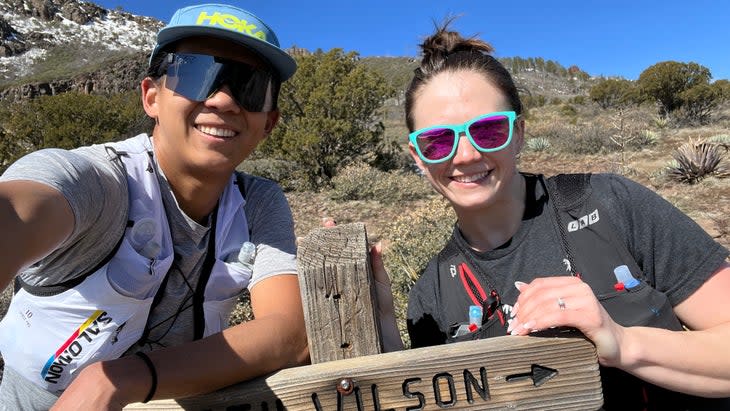How Runners in Phoenix Survived the Hottest Summer Ever
This article originally appeared on Trail Runner
The city of Phoenix, Arizona, made national news at the end of July: 31 consecutive days of heat above 110 degrees Fahrenheit, breaking its 18-day record in 1974.
Besides being known for its unrelenting heat, desert landscape, and a diverse and vibrant urban Indigenous population, Phoenix is also home to a thriving running community, with several local running clubs and stores (Sole Sports, Runner's Den, Tortoise & Hare Sports, to name a few), a series of races, and Aravaipa Running, a popular trail and ultra-race organizing company.
RELATED: The Great Cooling Revolution in Endurance Sports
According to data from the Environmental Protection Agency, extreme heat is the number one weather-related cause of death in the U.S., killing more people most years than hurricanes, floods, and tornadoes combined. And yet summer is also a key training season for many races in the fall like the Chicago Marathon, Marine Corps Marathon, and the New York City Marathon.
As this year is likely becoming the hottest year on record, it is the residents from some of the country's hottest regions who will continue taking the most heat. We reached out to several runners based in Phoenix to learn about best practices when adapting to extreme heat.
Stay Wet
Heat of vaporization is the basic physics principle for how the body cools itself through sweating. As the body's temperature rises above a certain threshold, the brain tells the sweat glands to perspire, and while the sweat evaporates from one's skin, it takes the heat with it.
Fortunately, water from external sources does the same thing to cool the body, before you naturally start to sweat. "Keeping yourself wet is a great cooling strategy," said Jamil Coury, ultrarunner and CEO of Aravaipa Running. "If you have a cold bucket of water or some ice water, think about soaking yourself before you head out in the heat. In dry heat like we have in Phoenix, I always carry water with me, not only for hydration, but to keep my clothes or body wet, since it has the same cooling effect as your natural sweating mechanism."
Jacky Hunt-Broersma is another Phoenix-based ultrarunner, coach, and cancer survivor, who is in the middle of her 13.1 Project. "When you run in the heat, sometimes it's easy to forget how much you're sweating and how much salt you're losing," she said. Her 13.1 project includes running a half marathon distance every day for 250 consecutive days to honor those who are fighting cancer, survived cancer, or lost their lives to cancer.

"I am usually out of the door by 5 A.M. Most mornings this summer are around 90 degrees so I have to stay on top of my hydration game," said Hunt-Broersma. "I make sure to take in plenty of electrolytes, since water itself might not be enough."
Nikki Duplissa, a runner, fitness lover, and school psychologist based in Gilbert, about 30 minutes east of Phoenix, also emphasized the importance of preventative hydration. "If you think you have enough water, you might underestimate what you need. I tend to not sweat so I make sure I run with a water bottle."
Stash Water Strategically
Running in extreme heat requires careful planning of water stops, shades, and even indoor cooling breaks. The Centers for Disease Control and Prevention recommends that "a worker performing heavy work in 104-degree temperatures should work for 20 minutes and rest for 40 minutes." Though many ultrarunners boast about their heat endurance abilities, it is always wise to plan for frequent water stops, quick cooling breaks, and possibly a change of temperature, indoors or outdoors.
"Running at 100 degrees or higher could be dangerous. You can always plan your route so you can get some air-conditioning and cool down before you go again," said Hunt-Broersma. "Water stops are critical. Maybe it's a route around your house or your car so you can refill your water bottle."
The increasing heat is not only concerning to runners, but also to race organizers like Coury. He first shared the tip of stashing water in a familiar long run route. "If you are going for a long run in the Phoenix area and don't have the luxury of driving a couple of hours out to Flagstaff, or to the mountains where it's cooler, you need to either plan the route with water fountains, or stash a water bottle in different spots along the way."
As a racer organizer, Coury also started the very popular Insomniac Night Trail Run Series from April to September. The distance ranges from three miles to nearly 50 miles. "When the temperature reaches over 110 degrees during the day, we move to running at night. It's a loop and we have unlimited ice and water. Some runners see it as a supported long run (to prepare for their ultra races)."
Prioritize Wearing Protective Gear
Light-colored, quick-dry clothing protects the skin against U.V. rays and helps with cooling. "I used to run without a shirt on to stay cool, but now I always wear a shirt to shield my skin from the sun," said Nathaniel Chan, ultrarunner, Hoka Flyer, and social media manager for Sole Sports in Phoenix.
As Chan prepares for his first 100-mile race, Arizona's Javelina Jundred, in late October, he sometimes has to run in the middle of the day to acclimate to the heat. "I was raised in Phoenix and ran cross country, so the heat is not a strange element to me." Chan often trains in the South Mountain Park area, one of the largest municipally managed parks in the nation. "Recently, I started wearing a button-up mountain running shirt. You can either button up or down, depending on how hot it is. Hat and sunscreen are essentials. I also use an ice bandana."

With more runners carrying ice with them on the run or race, Aravaipa Running has recently updated its policy on ice. "We no longer ration ice for our races. At one of our races this year, we had a local ice and water company that dropped an ice trailer for us. At Javelina, all runners have unlimited ice to use. They can take as much ice as they need to stay cool," said Jamil Coury.
One non-negotiable intervention while running in extremely hot conditions is anti-chafe cream. As an adaptive athlete, Jacky Hunt-Broersma always carries Squirrel's Nut Butter with her in the summer. "I have a lot more rubbing with my stump when I sweat a lot more in the summer. My stump also gets swollen and when it does, my prosthetic won't fit. I have to apply the Nut Butter frequently to make sure my skin is good. I have to prevent my skin from breaking out or getting swollen. It's an extra step in the summer."
Embrace the Collective
Outside columnist Alex Hutchinson listed out "numerous explanations we could offer for why life seems to suck more when you're trying to push your limits all alone." Though the article focuses more on racing and time trials, it's not hard to imagine that running in the heat with others' company makes it feel easier.
For Hunt-Broersma's 250 days of running a half marathon each day to raise funds for sarcoma cancer research, she has welcomed other runners to join her on her runs, including those visiting from out of town. In her blog post about this project, Hunt-Broersma wrote:
"Run virtually with me, join me out in Arizona, run 1 mile, run 13.1 miles, run a marathon, but keep on moving." On her Instagram account, she posts all her group runs that others have joined. "Recently, someone flew in from Kentucky to run with me in honor of his father who recently passed away. Someone who recently started at Arizona State University came to town and joined me for a trail run. We have a group on Strava and I'm always welcoming others' company."
"When we run with others, sometimes we forget we're suffering," said Chan. Sole Sports hosts group runs on Mondays and Thursdays in its Tempe location. At its Arcadia location, runners join the Valley Runners at Fate Brewing in Phoenix. "Even for group runs that start at 6:30 P.M. the sun is still out and it's very hot outside, but we brace the heat together, and we have a beer to celebrate afterwards."

Give Yourself a Break
A flexible mindset is critical as runners navigate summer heat. "Doing an indoor workout like a class at Orange Theory has been great for me," said Duplissa. Ever since finishing graduate school and starting her new role as a school psychologist, Duplissa knew that her focus would be more on work and less on running for a few more months. "I'll be looking for a race soon."
As a race director, Coury also tried to accommodate runners' needs and remain as adaptable as possible. "We usually have a monsoon season in the Southwest, but it came late this year. When we have a high heat index, we'll delay the race start a bit later, or relax our drop-down standards. When we have high temperatures mid-race, we allow people to drop down without a penalty. We don't want to mark those who aren't feeling well in the heat with a DNF (Did Not Finish)."
RELATED: The Basics of Heat Training for Running
Hunt-Broersma balances her schedule with her kids' needs. "Living in Phoenix has taught me to be flexible. I have to drop my kids off at school in the morning, so each run might not turn t out to be exactly how I have planned. You might have to learn to break your runs into two sessions, or run on a treadmill."
Most importantly, Hunt-Broersma practices a gratitude mindset. "Even though the first mile is always uncomfortable, and I have to wear an extra sock in my stump, I am grateful to be alive and running with and for others."
For exclusive access to all of our fitness, gear, adventure, and travel stories, plus discounts on trips, events, and gear, sign up for Outside+ today.

